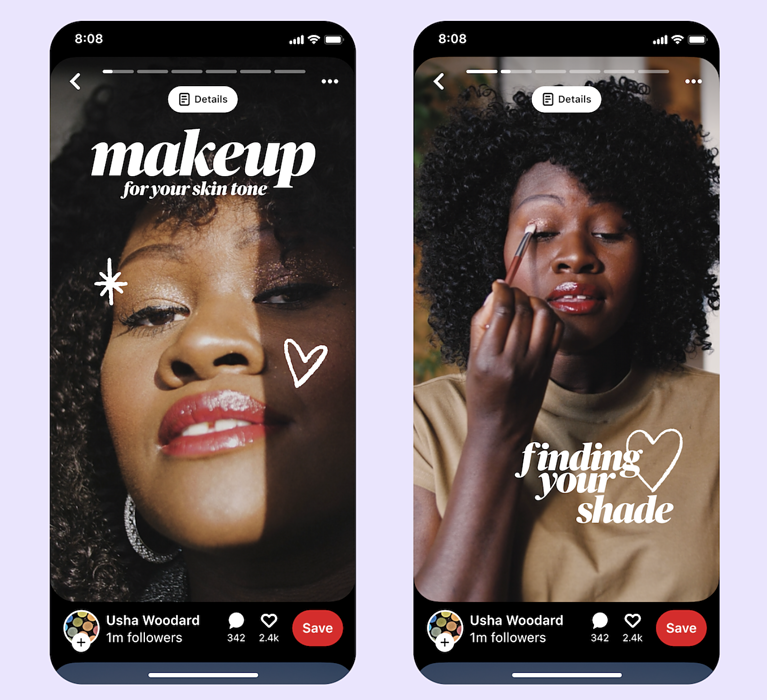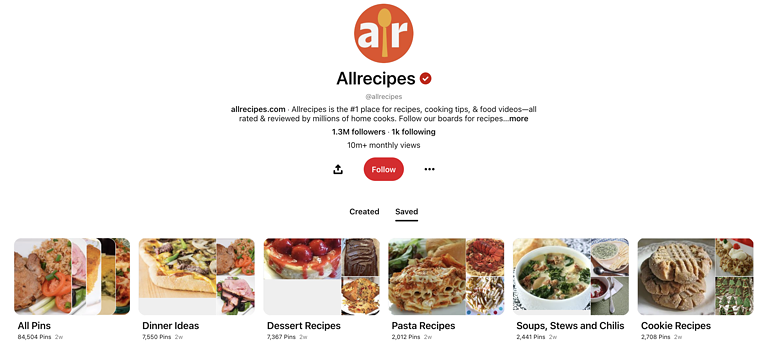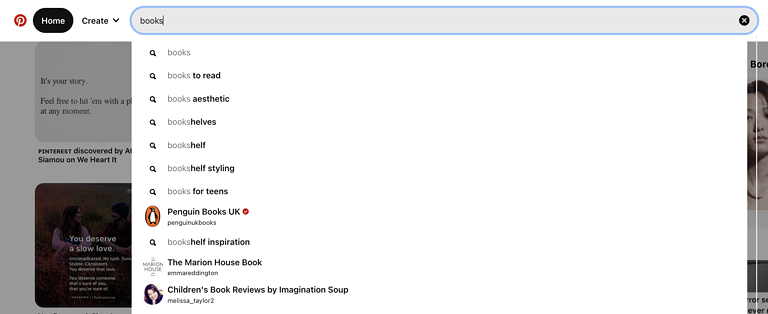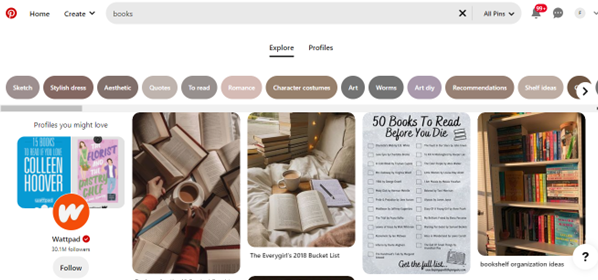SEO
How To Use Pinterest For Ecommerce

Pinterest is one of the least popular, most underused social media platforms for brand marketing.
However, the lack of popularity is not due to the lack of potential.
Pinterest, when used right, can add immense value to ecommerce brand success.
Pinterest bursts with potential, but it also has its own playbook. It is different than other social platforms, and requires a unique approach to win.
From investing in Pinterest ads to building a consistent posting schedule, in this article, you’ll find some best practices and tips on building successful Pinterest marketing campaigns.
But before we get to that, let’s first talk about whether Pinterest is good for ecommerce.
Is Pinterest Good For Ecommerce?
“Don’t spread yourself too thin!”
This is a popular piece of advice people give to ecommerce brands starting social media marketing. And it is valuable advice.
So, is it worth going into Pinterest if you already have a Facebook, Instagram, or TikTok account?
Yes, in most cases.
Pinterest has immense shopping potential, perhaps more so than all the other social media platforms.
The platform offers fluff-free, simple suggestions. This is why Pinterest is the go-to place for customers looking for new brands or product inspirations.
80% of weekly Pinterest users have discovered a new brand or product via Pinterest.
55% of Pinterest users get on the app specifically to search for products.
More importantly, Pinterest shoppers have 85% bigger baskets than shoppers on other platforms.
All of these statistics hint at one thing, and one thing only.
Pinterest is not just good for ecommerce. It is absolutely unmissable for any ecommerce brand looking to engage its audience.
A European DIY, gardening, and furniture marketplace brand, convinced of the value Pinterest offers for an ecommerce brand, jumped on the platform and tried engaging an audience from a new market using the platform’s ad products.
Their customer outreach efforts garnered 6.6 million impressions and led to a 7.9% lift in sales.
Why Use Pinterest For Ecommerce?
Besides being good for ecommerce, many other factors make Pinterest the ultimate marketing platform for brands looking to drive ecommerce growth.
Here’s why:
Pinterest Allows Omnichannel Marketing
The modern customer’s buying journey is more complex than ever.
This is why you need to multiply your customer touchpoints and be where your audience is to increase the chances of winning them as customers.
An omnichannel marketing strategy helps with that – and Pinterest helps run an omnichannel campaign.
Pinterest is home to a unique audience, using the app with a fixed goal in mind.
Marketing on Pinterest takes your brand to this audience through a content format they love the most – engaging visuals. This helps prospects remember brands and eventually shop from them when needed.
Image Search Capabilities
The rise of visual search has increased the importance of Pinterest for ecommerce.
30% of U.S. adults (34 and younger) have used visual search for shopping as of August 2022.
The Pinterest mobile app has the Pinterest Lens feature, which users can use for visual searches. This is similar to Google Lens, but Pinterest has a more extensive image database, generating better results.
Marketing on Pinterest helps you jump on the rising visual search trend before everyone else, enabling you to gain an edge over the competitors.
An Ecosystem Built To Support Brands
Pinterest has invested heavily in building an ecommerce-friendly ecosystem.
It gives verified sellers a verified merchant tag, reinforcing the brand’s credibility.
The platform also has excellent ad products that can help brands maximize their reach and get closer to their goals.
Advanced Pinterest Analytics help you track your efforts and optimize them for better results.
Lately, Pinterest has also been experimenting with an in-app checkout feature that will let the buyers complete their purchase without leaving the app.
These features combine to make Pinterest a healthy home for ecommerce growth.
A Conversion-Focused Audience
89% of weekly Pinners use Pinterest for inspiration in their path to purchase. This is perhaps why Pinners are 7x more likely to buy things they’ve saved.
Marketing on Pinterest effectively helps you reach these conversion-ready shoppers and get them tumbling through your sales funnel.
Pinterest Ecommerce Strategy
Now that we have you all riled up about Pinterest and its ecommerce potential, let’s help you set up a Pinterest marketing campaign with some proven best practices:
Start With Creating A Business Account
First things first, you will need a Pinterest business account to start marketing on the platform, which is pretty easy to create.
A Pinterest business account gives you access to the platform’s merchant tools, like Pinterest Analytics and ads.
Make sure to include complete business information within your profile: your business name, logo, and website address.
You can only connect to one website on Pinterest. Preferably, choose the one you make sales on.
Identify Your Pinterest Goals
As with any marketing strategy, your Pinterest strategy will be defined by a set of goals.
Think: what is it that you want to achieve through Pinterest? Increased brand awareness? More sales?
Once you have identified your goals, it will become easier for you to define your content strategy and start pinning.
Create Outstanding Pins
Success on Pinterest – or any social platform, for that matter – comes from attention.
Unlike other social platforms, Pinterest is crowded with visuals. Therefore, it may be tougher to stand out with less-than-outstanding Pins.
Create aesthetically pleasing, on-brand Pins with eye-catching colors to help them stand out from the ever-growing Pinterest crowd.
When creating image Pins, stick to vertical images with a 2:3 aspect ratio to make sure your Pins appear high quality and look complete.
 Screenshot from Pinterest, January 2023
Screenshot from Pinterest, January 2023Consider linking the pin to a landing page to drive traffic to your ecommerce store. Make sure the landing page content aligns with what’s featured on the pin to drive user satisfaction.
Write power titles and descriptions for your Pins. Pinterest allows 100 characters for titles, and 500 characters for descriptions. Use this space to create eye-catching and optimized titles and descriptions that drive clicks and engagement.
Try to include bullets as you write descriptions to increase the digestibility of the content. No one likes reading blocks of text, especially when they are scrolling Pinterest.
Make video Pins as well to engage your audience and keep your feed from looking monotonous.
When creating a video Pin, start with a powerful hook that captures and holds the attention and includes closed captions for people viewing on mute.
 Screenshot from Pinterest, January 2023
Screenshot from Pinterest, January 2023The ideal length for organic videos is between 15 seconds to a minute, and 6 to 15 seconds for ads, according to Pinterest. Keep your videos within these ranges.
Video creatives matter as well. Eye-catching video creatives can go a long way. Cadbury generated 134% higher engagement rates while attempting to drive brand awareness for its new products, all through dazzling video creatives.
Pick a strong cover image for your video Pin that tells the viewers what the video is about.
Finally, don’t forget to use Idea Pins.
Idea Pins are like Pinterest stories. Pinterest calls them multi-stage canvases. Idea Pins are a great way to engage your audience and share ideas in a compelling manner.
 Screeshot from Pinterest Newsroom, January 2023
Screeshot from Pinterest Newsroom, January 2023Build Organized Boards
As you start pinning, it is crucial to stay organized.
Sort your content out in well-defined boards.
You can create individual boards for all your product categories. For example, if you sell clothes, you can create separate boards for men, women, summer dresses, formal wear, etc.
Check out how Allrecipes has organized all their recipes into well-defined boards:
 Screenshot from Pinterest, January 2023
Screenshot from Pinterest, January 2023Optimize Your Pins For SEO
Pinterest gets, and drives, massive traffic. In May 2022, around 945 million visits were reported to Pinterest.com.
The tremendous traffic that Pinterest is getting not only highlights exposure opportunities but also underscores its capabilities of multiplying your ecommerce store traffic.
But first, you will need to gain visibility on the platform. And for that, you will need SEO.
Pinterest SEO is pretty simple. Find out the relevant keywords. You can do this using Pinterest’s guided search, Google AdWords, or Pinterest Ad targeting.
 Screenshot from Pinterest, January 2023
Screenshot from Pinterest, January 2023You can also pick up good keywords by searching for relevant products or themes on Pinterest and looking at how the platform has categorized and subcategorized the Pins.
 Screenshot from Pinterest, January 2023
Screenshot from Pinterest, January 2023Looking at the competitors’ Pins may also help uncover some great keywords.
Use these keywords in your Pin titles and descriptions and board titles and descriptions to increase relevance with the users’ searches.
Besides relevance, engagement is also said to drive visibility. So, try to build engagement for increased exposure.
Stay Consistent With Publishing
As cliche as it sounds, consistency is the key to Pinterest’s success.
Build a pinning schedule and stick to it.
Brands have seen their traffic spike after increasing their pinning frequency.
There’s no magic number that you need to hit. Start with as many Pins as you can manage without compromising the quality, and gradually build your way up.
Just make sure not to post too little content. You may lose your prospects to competitors. And don’t post too frequently so as to overwhelm your audience.
Strike a nice balance.
Keep Alternating Your Content
Your users might get bored of your feed if it is filled with the same kind of content. Keep things interesting by mixing up your posts.
Share informative content like blogs, infographics, guides, product-related posts, and videos.
Invest In Pinterest Ads
If you want to kick-start your Pinterest journey, consider investing in Pinterest ads.
The platform offers a powerful advertising system. Pinterest ads are 2.3x more cost-efficient and generate 2x higher return on ad spend (ROAS) for retail brands than other social media.
You also have access to a wide variety of ad formats that you can choose from.
Pinterest also offers extensive ad targeting capabilities to help you reach your audience in the best possible ways.
Track Pinterest Analytics
Pinterest offers a platform native analytics tool – Pinterest Analytics – to help brands measure their marketing efforts against their goals.
This tool offers all the metrics you need to gain insight into your campaign performance, like referral traffic, leads generated, engagement, etc. Use these metrics to determine the efficacy of your campaigns and guide your future marketing efforts.
Tips For Successful Pinterest Marketing
The best practices in the previous section are good enough to help you set off your Pinterest journey. But here are some additional tips to further fine-tune your campaigns:
Ensure Consistent Branding
Customers shop with brands they trust – and nothing builds trust like consistent branding.
This may be why consistent branding is said to increase revenue by 33%.
Ensure your Pinterest profile is consistent with the branding across all other social platforms.
Stay Current With Trends
Pinterest, like all social media, is big on trends and rewards brands that stick to what’s trending.
Find out what’s trending on the platform at any given time. If it fits your brand, jump on the trend to demonstrate relevance and maximize exposure.
Use Rich Pins
Rich Pins pull information from your website so your users can find out all they need to know about what you are featuring in your Pins.
Use Rich Pins to drive user engagement and satisfaction. There are three different types of Rich Pins.
Use the ones that are most relevant to your brand.
Follow And Engage With Other Accounts
You need to build your community to get engagement on Pinterest. And for that, you will have to invest some time engaging with other relevant accounts on the platform.
Like, comment, and re-pin posts from various accounts to engage with others on the platform and increase your own engagement.
Final Words
Pinterest is an underused goldmine of ecommerce success.
Leverage its potential by creating outstanding Pins and sharing them through your business accounts.
Make sure your content aligns with your audience’s preferences and goes out regularly and frequently to stay on top of your customer’s minds.
Track your Pinterest analytics and use your findings to optimize your Pinterest marketing strategy for continued growth.
More resources:
Featured Image: Kaspars Grinvalds/Shutterstock
SEO
Measuring Content Impact Across The Customer Journey

Understanding the impact of your content at every touchpoint of the customer journey is essential – but that’s easier said than done. From attracting potential leads to nurturing them into loyal customers, there are many touchpoints to look into.
So how do you identify and take advantage of these opportunities for growth?
Watch this on-demand webinar and learn a comprehensive approach for measuring the value of your content initiatives, so you can optimize resource allocation for maximum impact.
You’ll learn:
- Fresh methods for measuring your content’s impact.
- Fascinating insights using first-touch attribution, and how it differs from the usual last-touch perspective.
- Ways to persuade decision-makers to invest in more content by showcasing its value convincingly.
With Bill Franklin and Oliver Tani of DAC Group, we unravel the nuances of attribution modeling, emphasizing the significance of layering first-touch and last-touch attribution within your measurement strategy.
Check out these insights to help you craft compelling content tailored to each stage, using an approach rooted in first-hand experience to ensure your content resonates.
Whether you’re a seasoned marketer or new to content measurement, this webinar promises valuable insights and actionable tactics to elevate your SEO game and optimize your content initiatives for success.
View the slides below or check out the full webinar for all the details.
SEO
How to Find and Use Competitor Keywords

Competitor keywords are the keywords your rivals rank for in Google’s search results. They may rank organically or pay for Google Ads to rank in the paid results.
Knowing your competitors’ keywords is the easiest form of keyword research. If your competitors rank for or target particular keywords, it might be worth it for you to target them, too.
There is no way to see your competitors’ keywords without a tool like Ahrefs, which has a database of keywords and the sites that rank for them. As far as we know, Ahrefs has the biggest database of these keywords.
How to find all the keywords your competitor ranks for
- Go to Ahrefs’ Site Explorer
- Enter your competitor’s domain
- Go to the Organic keywords report
The report is sorted by traffic to show you the keywords sending your competitor the most visits. For example, Mailchimp gets most of its organic traffic from the keyword “mailchimp.”


Since you’re unlikely to rank for your competitor’s brand, you might want to exclude branded keywords from the report. You can do this by adding a Keyword > Doesn’t contain filter. In this example, we’ll filter out keywords containing “mailchimp” or any potential misspellings:


If you’re a new brand competing with one that’s established, you might also want to look for popular low-difficulty keywords. You can do this by setting the Volume filter to a minimum of 500 and the KD filter to a maximum of 10.


How to find keywords your competitor ranks for, but you don’t
- Go to Competitive Analysis
- Enter your domain in the This target doesn’t rank for section
- Enter your competitor’s domain in the But these competitors do section


Hit “Show keyword opportunities,” and you’ll see all the keywords your competitor ranks for, but you don’t.


You can also add a Volume and KD filter to find popular, low-difficulty keywords in this report.


How to find keywords multiple competitors rank for, but you don’t
- Go to Competitive Analysis
- Enter your domain in the This target doesn’t rank for section
- Enter the domains of multiple competitors in the But these competitors do section


You’ll see all the keywords that at least one of these competitors ranks for, but you don’t.


You can also narrow the list down to keywords that all competitors rank for. Click on the Competitors’ positions filter and choose All 3 competitors:


- Go to Ahrefs’ Site Explorer
- Enter your competitor’s domain
- Go to the Paid keywords report


This report shows you the keywords your competitors are targeting via Google Ads.
Since your competitor is paying for traffic from these keywords, it may indicate that they’re profitable for them—and could be for you, too.
You know what keywords your competitors are ranking for or bidding on. But what do you do with them? There are basically three options.
1. Create pages to target these keywords
You can only rank for keywords if you have content about them. So, the most straightforward thing you can do for competitors’ keywords you want to rank for is to create pages to target them.
However, before you do this, it’s worth clustering your competitor’s keywords by Parent Topic. This will group keywords that mean the same or similar things so you can target them all with one page.
Here’s how to do that:
- Export your competitor’s keywords, either from the Organic Keywords or Content Gap report
- Paste them into Keywords Explorer
- Click the “Clusters by Parent Topic” tab


For example, MailChimp ranks for keywords like “what is digital marketing” and “digital marketing definition.” These and many others get clustered under the Parent Topic of “digital marketing” because people searching for them are all looking for the same thing: a definition of digital marketing. You only need to create one page to potentially rank for all these keywords.


2. Optimize existing content by filling subtopics
You don’t always need to create new content to rank for competitors’ keywords. Sometimes, you can optimize the content you already have to rank for them.
How do you know which keywords you can do this for? Try this:
- Export your competitor’s keywords
- Paste them into Keywords Explorer
- Click the “Clusters by Parent Topic” tab
- Look for Parent Topics you already have content about
For example, if we analyze our competitor, we can see that seven keywords they rank for fall under the Parent Topic of “press release template.”


If we search our site, we see that we already have a page about this topic.


If we click the caret and check the keywords in the cluster, we see keywords like “press release example” and “press release format.”


To rank for the keywords in the cluster, we can probably optimize the page we already have by adding sections about the subtopics of “press release examples” and “press release format.”
3. Target these keywords with Google Ads
Paid keywords are the simplest—look through the report and see if there are any relevant keywords you might want to target, too.
For example, Mailchimp is bidding for the keyword “how to create a newsletter.”


If you’re ConvertKit, you may also want to target this keyword since it’s relevant.
If you decide to target the same keyword via Google Ads, you can hover over the magnifying glass to see the ads your competitor is using.


You can also see the landing page your competitor directs ad traffic to under the URL column.


Learn more
Check out more tutorials on how to do competitor keyword analysis:
SEO
Google Confirms Links Are Not That Important

Google’s Gary Illyes confirmed at a recent search marketing conference that Google needs very few links, adding to the growing body of evidence that publishers need to focus on other factors. Gary tweeted confirmation that he indeed say those words.
Background Of Links For Ranking
Links were discovered in the late 1990’s to be a good signal for search engines to use for validating how authoritative a website is and then Google discovered soon after that anchor text could be used to provide semantic signals about what a webpage was about.
One of the most important research papers was Authoritative Sources in a Hyperlinked Environment by Jon M. Kleinberg, published around 1998 (link to research paper at the end of the article). The main discovery of this research paper is that there is too many web pages and there was no objective way to filter search results for quality in order to rank web pages for a subjective idea of relevance.
The author of the research paper discovered that links could be used as an objective filter for authoritativeness.
Kleinberg wrote:
“To provide effective search methods under these conditions, one needs a way to filter, from among a huge collection of relevant pages, a small set of the most “authoritative” or ‘definitive’ ones.”
This is the most influential research paper on links because it kick-started more research on ways to use links beyond as an authority metric but as a subjective metric for relevance.
Objective is something factual. Subjective is something that’s closer to an opinion. The founders of Google discovered how to use the subjective opinions of the Internet as a relevance metric for what to rank in the search results.
What Larry Page and Sergey Brin discovered and shared in their research paper (The Anatomy of a Large-Scale Hypertextual Web Search Engine – link at end of this article) was that it was possible to harness the power of anchor text to determine the subjective opinion of relevance from actual humans. It was essentially crowdsourcing the opinions of millions of website expressed through the link structure between each webpage.
What Did Gary Illyes Say About Links In 2024?
At a recent search conference in Bulgaria, Google’s Gary Illyes made a comment about how Google doesn’t really need that many links and how Google has made links less important.
Patrick Stox tweeted about what he heard at the search conference:
” ‘We need very few links to rank pages… Over the years we’ve made links less important.’ @methode #serpconf2024″
Google’s Gary Illyes tweeted a confirmation of that statement:
“I shouldn’t have said that… I definitely shouldn’t have said that”
Why Links Matter Less
The initial state of anchor text when Google first used links for ranking purposes was absolutely non-spammy, which is why it was so useful. Hyperlinks were primarily used as a way to send traffic from one website to another website.
But by 2004 or 2005 Google was using statistical analysis to detect manipulated links, then around 2004 “powered-by” links in website footers stopped passing anchor text value, and by 2006 links close to the words “advertising” stopped passing link value, links from directories stopped passing ranking value and by 2012 Google deployed a massive link algorithm called Penguin that destroyed the rankings of likely millions of websites, many of which were using guest posting.
The link signal eventually became so bad that Google decided in 2019 to selectively use nofollow links for ranking purposes. Google’s Gary Illyes confirmed that the change to nofollow was made because of the link signal.
Google Explicitly Confirms That Links Matter Less
In 2023 Google’s Gary Illyes shared at a PubCon Austin that links were not even in the top 3 of ranking factors. Then in March 2024, coinciding with the March 2024 Core Algorithm Update, Google updated their spam policies documentation to downplay the importance of links for ranking purposes.
The documentation previously said:
“Google uses links as an important factor in determining the relevancy of web pages.”
The update to the documentation that mentioned links was updated to remove the word important.
Links are not just listed as just another factor:
“Google uses links as a factor in determining the relevancy of web pages.”
At the beginning of April Google’s John Mueller advised that there are more useful SEO activities to engage on than links.
Mueller explained:
“There are more important things for websites nowadays, and over-focusing on links will often result in you wasting your time doing things that don’t make your website better overall”
Finally, Gary Illyes explicitly said that Google needs very few links to rank webpages and confirmed it.
I shouldn’t have said that… I definitely shouldn’t have said that
— Gary 鯨理/경리 Illyes (so official, trust me) (@methode) April 19, 2024
Why Google Doesn’t Need Links
The reason why Google doesn’t need many links is likely because of the extent of AI and natural language undertanding that Google uses in their algorithms. Google must be highly confident in its algorithm to be able to explicitly say that they don’t need it.
Way back when Google implemented the nofollow into the algorithm there were many link builders who sold comment spam links who continued to lie that comment spam still worked. As someone who started link building at the very beginning of modern SEO (I was the moderator of the link building forum at the #1 SEO forum of that time), I can say with confidence that links have stopped playing much of a role in rankings beginning several years ago, which is why I stopped about five or six years ago.
Read the research papers
Authoritative Sources in a Hyperlinked Environment – Jon M. Kleinberg (PDF)
The Anatomy of a Large-Scale Hypertextual Web Search Engine
Featured Image by Shutterstock/RYO Alexandre
-

 PPC4 days ago
PPC4 days ago19 Best SEO Tools in 2024 (For Every Use Case)
-

 MARKETING7 days ago
MARKETING7 days agoWill Google Buy HubSpot? | Content Marketing Institute
-
SEARCHENGINES7 days ago
Daily Search Forum Recap: April 16, 2024
-

 SEO7 days ago
SEO7 days agoGoogle Clarifies Vacation Rental Structured Data
-

 MARKETING6 days ago
MARKETING6 days agoStreamlining Processes for Increased Efficiency and Results
-
SEARCHENGINES6 days ago
Daily Search Forum Recap: April 17, 2024
-

 PPC7 days ago
PPC7 days agoHow to Collect & Use Customer Data the Right (& Ethical) Way
-

 SEO6 days ago
SEO6 days agoAn In-Depth Guide And Best Practices For Mobile SEO
















You must be logged in to post a comment Login